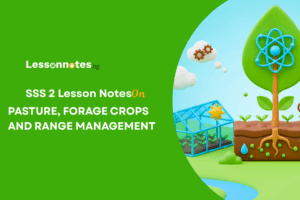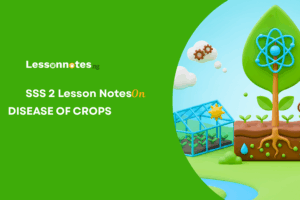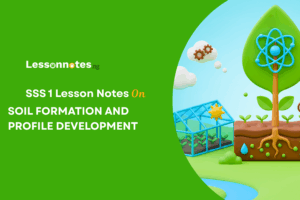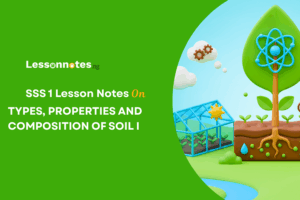Environmental Factors Affecting Agricultural Production SS1 Agricultural Science Lesson Note
Download Lesson NoteTopic: Environmental Factors Affecting Agricultural Production
INTRODUCTION
Environmental factors affecting agricultural production can be grouped into:
- Climate factors
- Biotic factors
- Edaphic factors.
- Climate: This is defined as the average weather condition of a place measured over a long period.
Factors Of Climate
It includes rainfall, relative humidity, temperature, light, wind, and pressure.
Each of the factors has its influence on agriculture. This is shown by the distribution of vegetation and crops in the climatic zones. The result is that when the soil condition is favorable, thick evergreen forest develops.
a. Rainfall: This is defined as the amount and distribution of water precipitation within a given time in a given area.
Rainfall Distribution And Pattern
West Africa is known for its high temperature throughout the year. It is brought about by the southwest monsoon trade wind blowing from the Atlantic Ocean.
The wind blowing from the ocean to the inland drops some water. A narrow part of the coast has rainfall throughout the year against the rest of the region. As we move from the coast, the amount of rainfall decreases. By the time the wind gets to the northern part of the country, there is little or no moisture left in it. Here, less rainfall is experienced per year. In the coastal area, the rainy season ranges from 8 months to all year round while in the north, the rainy season lasts only 3 to 4 months. The moisture required affects crop and livestock production. In the coastal areas, most of the southern parts, crops adapted to heavy rainfall predominantly trees, yam, maize, rice, fruit, banana, etc. Much animal rearing does not take place here due to the high humidity rate which exposes the animals to tsetse fly infection.
Only animals which can resist the attack of trypanosomiasis can be seen in this area. Examples are N’dama and Muturu breeds of cattle, dwarf sheep and goats, and poultry. Those crops that can thrive well in the northern part with little rainfall or resistance to drought are guinea corn, millet, groundnut, cowpeas, cotton etc.
Importance/Effect Of Rainfall
i. It determines the distribution of crops and animals.
ii. It helps to dissolve nutrients in the soil making it available for plant use
iii. It is necessary for seed germination.
iv. Excessive rainfall leads to leaching of nutrients and causes soil erosion.
v. It determines the type of vegetation in an area.
vi. Insufficient rainfall causes crop failure and poor yield.
b. Temperature: Is defined as a measure of the heat energy which a body contains or the degree of hotness or coolness of a place, at a point in time. Temperature varies from the coastal areas to the extreme north. In the dry season, the temperature is not as high in the coaster area as in the extremely high north.
Importance/Effects Of Temperature
i. It affects the distribution of crops and animals.
ii. Necessary for germination of seed.
iii. Unfavorable temperature may result in seed dormancy
iv. High temperature may cause premature dropping of fruits and sudden death of livestock in heat stress.
v. High temperature reduces the performance of livestock.
c. Sunlight
Importance/Influence
i. It is necessary for photosynthesis.
ii. It affects the rate of production in poultry.
iii. It affects evapotranspiration.
d. Wind
Importance
i. High wind may cause wind erosion.
ii. It aids seed and fruit dispersal
iii. It can aid pollination and the spread of disease.
iv. It helps in the distribution of rainfall and changes in seasons e.g. rainy and dry seasons
v. High wind velocity causes damage to crops.
e. Relative Humidity
Influence:
i. It results in the formation of rain.
ii. It affects the performance of crops and animals
iii. High humidity in poultry causes moldiness of feed and litter.
iv. Low humidity leads to heat stress in animals.
v. Relative humidity determines the type of pests prevalent in an area.
vi. High relative humidity forms the re-growth of disease pathogens.
ASSIGNMENT
- What is the climate?
- Discuss the importance of rainfall in agriculture.
- What is temperature?
- What is the difference between a farm and a farmstead?
- Outline five principles of farmstead layout.
Biotic Factors Or Biological Factors Affecting Crops And Animal Production
- Predators: These are living organisms that prey or feed on other organisms. Examples are birds, rodents, insects, etc. Some are beneficial and some are destructive. Some control harmful pests of crops and animals, while others feed on other animals e.g. hawks etc.
- Parasites (Paratisism): A parasite is an organism which lives on or in another living organism known as the host. It obtains its food from the body of its living host. Often, a parasite harms its host by causing diseases or death.
Types Of Parasites
a. Endoparasites: – These are parasites which live inside or within the body of other animals. e.g. liver fluke, tapeworm, roundworm or ascaris.
b. Ectoparasite: – Parasites that live outside or on the host. Examples are ticks, lice, mites, insect bugs, fleas, etc.
c. Soil Organism: Soil organisms can be classified into microorganisms or microorganisms. Microorganisms are bacteria, viruses e.t.c, while macro organisms are rodents, termites, centipedes etc. Some like bacteria and fungi can cause disease, and some aid aeration in soil, hence improving soil fertility. Some like root nodule bacteria can fix nutrients directly to plants and soils. Some help in the decomposition of plant and animal material to form humus.
d. Pests: These organisms cause damage or destroy crops either in the field or in stores. They include insects, rodents, birds and some animals e.g. monkeys. They reduce the yield of crops and animals thereby reducing the farmer’s income. Some are vectors or carriers of diseases. The cost of their control increases the cost of production.
e. Diseases: Disease is a situation in plants or animals in which there is a deviation of the plant or animal from normal state of health. Disease can be caused by pathogens which are viruses, bacteria, fungi, protozoa etc. They cause a reduction in the yield of crops and animals. They can cause loss or death of plants and animals. The cost of control increases the cost of production which affects the income of the farmers.
f. Symbiosis: In mutualism, two organisms live together for the mutual benefit of each other. Termites and the protozoa living in their guts are mutualistic. The protozoa receive protection from termites; it helps in the breakdown of food in termites. The protozoa help them to digest it.
g. Weeds: They compete with crops for space, water, nutrients and sunlight. Some may harbour diseases and pests. They reduce the yield of crops. The control increases the cost of production.
Edaphic Factors Or Physical Factors
a. Soil pH: This is the degree of acidity or alkalinity of soil.
i. It affects the growth of plants.
ii. It affects the availability of soil nutrients to plants.
iii. It affects the presence of soil microorganisms
b. Soil Texture: This is the measure of fineness or coarseness of soil samples.
i. It determines the type of soil in an area.
ii. It determines the level of soil fertility.
iii. It determines the type of crops to be grown.
iv. It affects the level of leaching and erosion of the soil.
c. Soil Structure: This is the physical appearance of the soil according to the way individual particles are packed or arranged.
i. It determines the fertility of the soil.
ii. It determines the water-retaining capacity of the soil
iii. It determines the level of aeration.
iv. It determines the level of micro-organisms
ASSIGNMENT
- What is soil structure?
- Define soil texture.
- What is soil pH?
- State three features of soil texture
- List out any five soil organisms






















